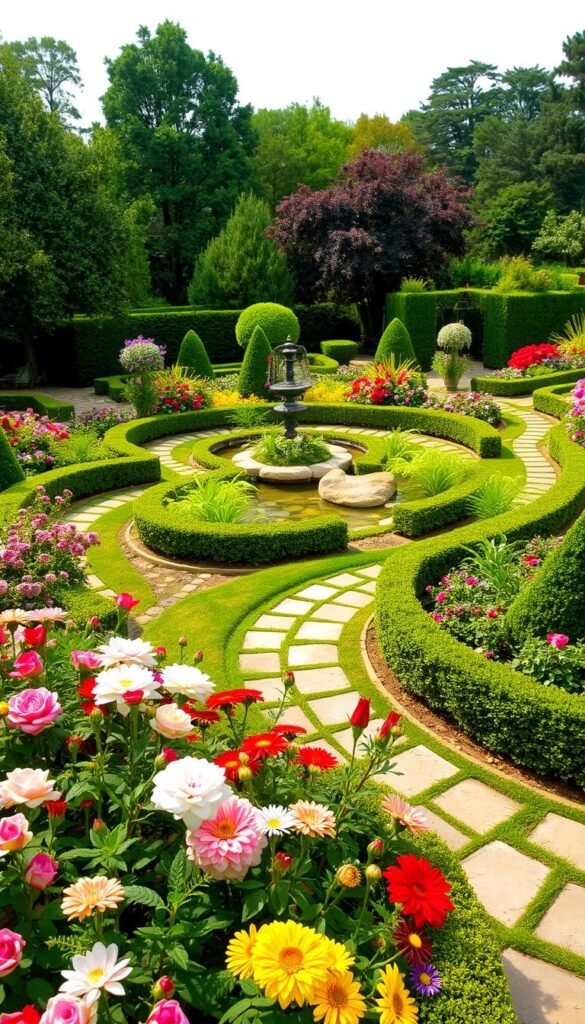Imagine stepping into an outdoor space that feels like an extension of your home – a place where every path, plant, and patio reflects your unique style. Whether you’re working with a cozy balcony or sprawling acreage, thoughtful planning can turn ordinary areas into extraordinary retreats. Scott McLeod of McLeod Landscaping Inc. shares insights from 30+ years of transforming properties across America.
This guide offers fresh approaches to reimagining your yard. Discover how to boost curb appeal with strategic plant placements or create hidden nooks for relaxation. You’ll find solutions that work whether you enjoy weekend DIY projects or prefer professional installations.
Great spaces don’t require endless budgets or expertise. Simple upgrades like layered lighting or native plants can make dramatic impacts. We focus on practical strategies you can implement gradually, mixing timeless principles with modern trends.
Your outdoor area should evolve with your lifestyle. Maybe you need play zones for kids, entertainment-ready patios, or low-maintenance greenery. These adaptable concepts help you craft environments that feel personal while increasing property value.
Kickstart Your Garden Transformation

Every outdoor area has potential; your journey starts with noticing it. Grab a notebook and walk through your space. What makes you smile? Maybe it’s that sturdy oak tree or the sunny corner where wildflowers peek through. These details matter—they’re your foundation.
Understanding Your Outdoor Potential
Track sunlight patterns for 3 days. Morning rays? Afternoon shade? This helps pick plants that thrive. Test soil pH with a $10 kit—it reveals what’ll grow best. Keep mature trees or shrubs that add structure. For quick wins, try easy backyard upgrades like mulching beds or adding potted herbs.
Setting a Friendly, Inspiring Tone
Start small if you’re new. Paint a bench bright blue. Hang string lights between posts. These tweaks build momentum. Remember, even tiny changes create ripple effects. One reader transformed her patio with $50 worth of thrifted planters. You don’t need grand plans—just action.
Need ideas? Browse gardening aesthetic inspiration for color schemes that match your vibe. Your space should feel like your happy place—not a magazine shoot. Progress beats perfection every time.
Designing a Functional Garden Layout
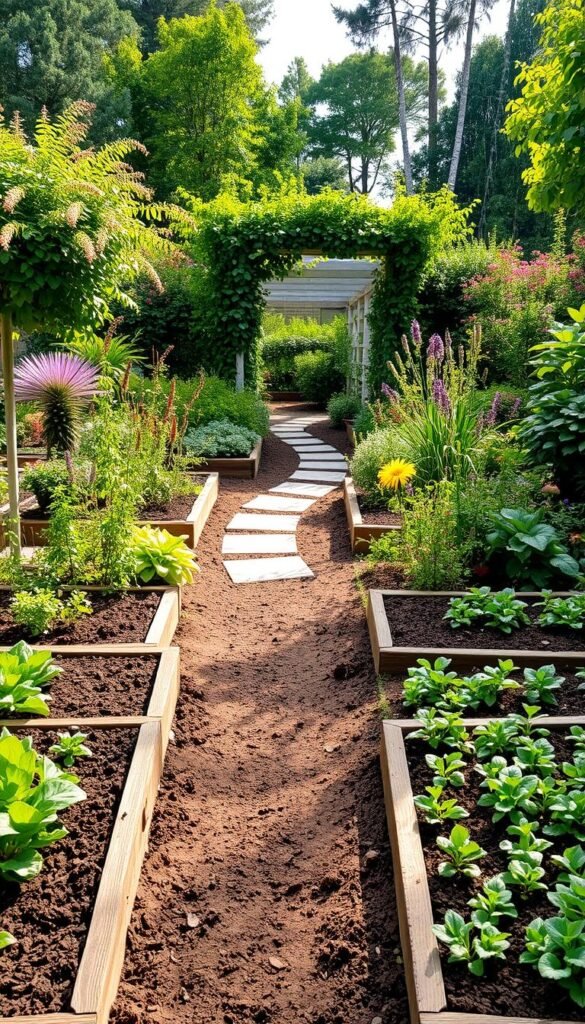
Crafting a layout that works starts with smart plant placement. Think of your space as a living puzzle—each piece needs the right neighbors and room to grow. Let’s break it down step by step.
Planning Plant Zones and Spatial Flow
Group plants by their needs. Sun lovers like tomatoes thrive together, while shade-tolerant herbs can cluster under taller greens. This reduces watering guesswork and boosts health. Leave 18-inch pathways between beds—wide enough for a wheelbarrow but narrow enough to reach plants easily.
Curved paths feel natural, while straight lines suit modern spaces. Try lining walkways with lavender or thyme for scent and texture. Need inspiration? Explore creative planting arrangements that blend beauty with purpose.
Balancing Tall, Mid-Sized, and Low-Growing Plants
Layer heights like a pro. Place corn or sunflowers northside to avoid shading smaller plants. Mid-level peppers add pops of color, while front-edge herbs stay handy for cooking. Check this quick guide:
| Plant Type | Height Range | Examples |
|---|---|---|
| Tall | 5-8 ft | Sunflowers, pole beans |
| Mid-Sized | 2-4 ft | Peppers, zinnias |
| Low-Growing | 6-18 in | Lettuce, thyme |
Sketch your plan first. Use graph paper—one square per foot. Mark water sources and sunny spots. Adjust until it feels right. Remember, even imperfect layouts grow into something special!
Choosing the Right Materials for Paving and Paths
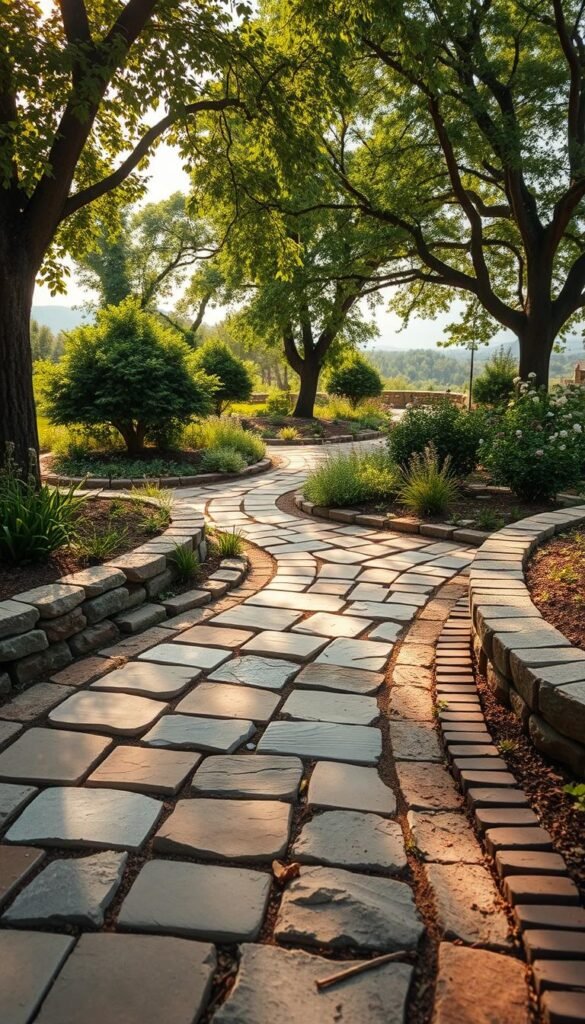
Your garden’s pathways set the stage for every step you take—both literally and visually. The materials you pick determine durability, maintenance, and how well they blend with your overall style. Let’s explore smart choices that balance practicality with personality.
Opt for Darker, Low-Maintenance Paving
Darker stones hide dirt and wear better than light ones. Reclaimed York stone, for example, develops a charming patina over time. As landscape designer Butter notes:
“Spaces with charcoal-gray slate or weathered granite require less scrubbing. They look richer after years of use compared to pale limestone.”
Consider these options for high-traffic areas:
| Material | Texture | Best For |
|---|---|---|
| Recycled brick | Rustic | Curved walkways |
| Basalt tiles | Smooth | Modern patios |
| Composite pavers | Wood-like | Pool surrounds |
Mixing Paving Textures for Visual Depth
Combine rough flagstones with sleek concrete for contrast. Irregular patterns slow the eye, making compact yards feel expansive. Try alternating square tiles with circular stepping stones—the varied texture adds playful energy.
Keep joints narrow (½ inch or less) to prevent weed growth. For budget-friendly flair, use stamped concrete mimicking natural stone. It offers the same look at half the cost, perfect for DIYers wanting premium style without the price tag.
Embrace Vertical and Container Garden Strategies
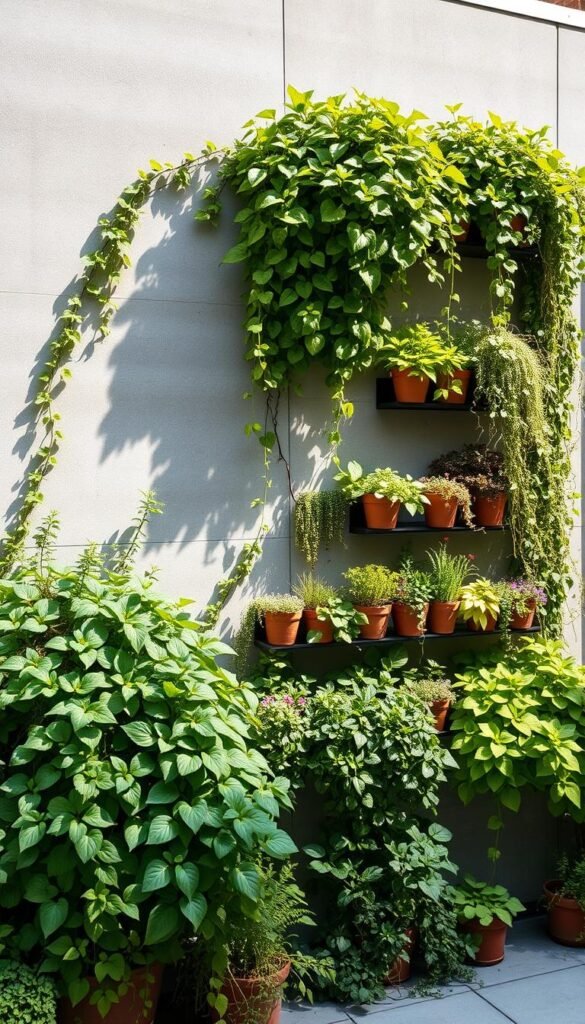
When ground space is limited, look up—your garden’s vertical surfaces hold untapped potential. Creative arrangements let you grow twice as many plants without expanding your footprint. Let’s explore how to turn walls, railings, and airspace into thriving green zones.
Maximizing Vertical Space for Climbing Plants
Climbing varieties like clematis or pole beans transform blank walls into living art. Install trellises with hooks that adjust as plants grow taller. Hanging baskets work wonders for strawberries or trailing flowers—just keep them within easy reach for watering.
Expert gardener Samantha Richards suggests:
“Vertical growth redirects energy upward, making small spaces feel airy and layered. It’s like adding a second story to your garden.”
Try these supports for different needs:
- Metal grids for heavy squash vines
- Twine nets for lightweight peas
- Wall-mounted pockets for herbs
Benefits of Large Containers and Tiered Arrangements
Oversized pots do more than save back strain—they create microclimates. Deeper soil retains moisture longer, reducing watering frequency. Place three-tiered planters near seating areas to blend fragrance and function.
Use containers as natural room dividers. A line of olive trees in troughs separates dining and play zones elegantly. For stability, choose materials like fiberstone that withstand weather shifts.
Mix heights in grouped planters:
| Level | Plant Type | Examples |
|---|---|---|
| Top | Trailing | Sweet potato vine |
| Middle | Bushy | Dwarf tomatoes |
| Base | Spillers | Creeping thyme |
Creating Defined Zones with Hardscaping and Borders
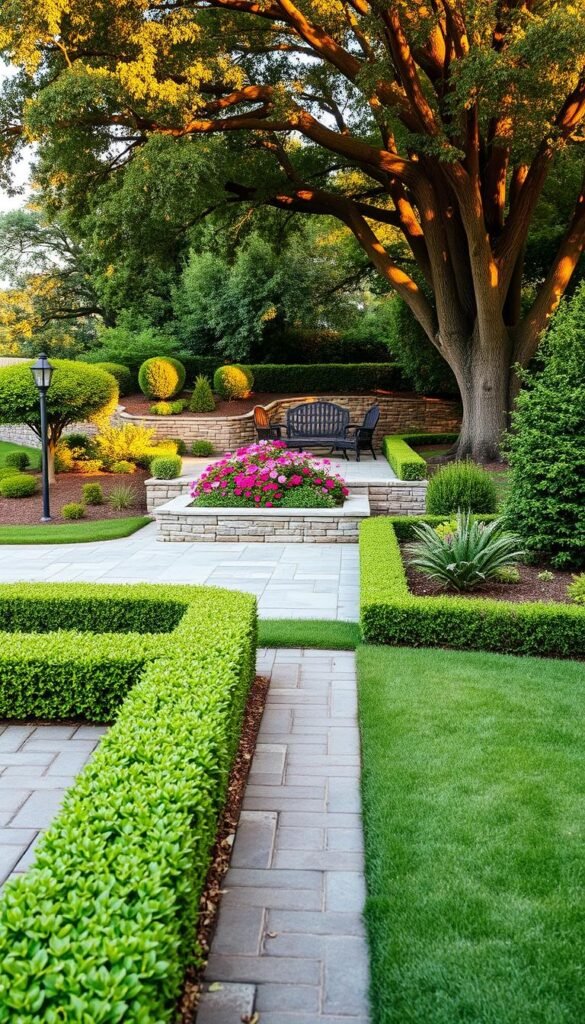
Think of your outdoor space as a collection of purposeful rooms. Carl Jones of TrexPro puts it perfectly:
“Clearly defined spaces give structure and trick the eye—even compact areas feel larger when each zone has a dedicated role.”
Start by mapping out where you want to eat, relax, and grow. A stone path leading to a dining spot tells visitors,“This is where we gather.”
Hardscaping materials do heavy lifting. Use contrasting pavers to separate seating areas from planting beds—try rectangular concrete slabs next to circular gravel sections. Decking creates instant functional zones, like this example:
- Composite wood platforms for dining sets
- Flagstone borders around fire pits
- Pergolas marking reading nooks
Containers offer flexible division. Line up tall planters filled with ornamental grasses between your lounge chairs and veggie patches. You’ll maintain airflow while softly directing foot traffic. For seasonal changes, swap out flowering annuals instead of rebuilding walls.
Balance is key. Connect zones with curved pathways or repeating plants. Jones suggests “using the same ground cover in adjacent areas to create visual handshakes.” A rosemary hedge might frame your dining space while spilling into nearby herb beds—unified yet distinct.
10 Garden Design Ideas That Elevate Your Landscape
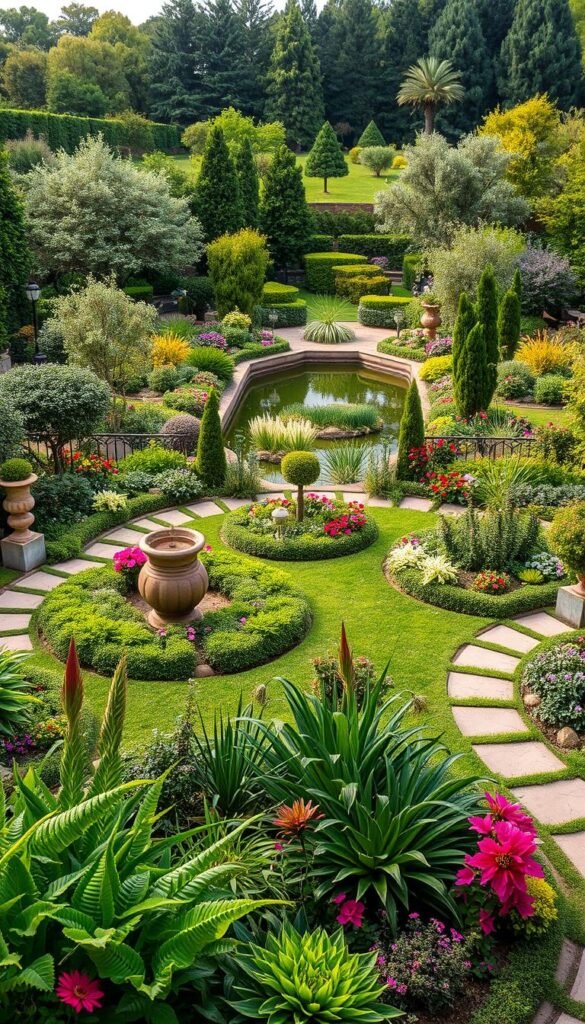
Unlock your outdoor potential through innovative strategies that marry beauty with purpose. These foundational concepts work like building blocks—combine them to craft spaces that feel uniquely yours. Whether you’re refining a tiny urban plot or reworking acres, these approaches adapt to your vision and budget.
Strategic plant groupings create visual rhythm while reducing maintenance. Curved pathways invite exploration, while layered lighting extends enjoyment into evening hours. Water features add soothing sounds, and vertical gardens maximize every square inch. Each element complements others, like pieces in a living puzzle.
Landscape architect Mia Torres observes:
“The magic happens when textures, colors, and functions harmonize. A gravel patio feels intentional next to wildflower beds when tied together with repeating shrubs.”
Consider these adaptable starting points:
- Focal points like specimen trees or sculptures
- Multi-season plants for year-round interest
- Edible borders that blend herbs with ornamentals
Mix formal and informal touches—boxwood hedges paired with meandering stone paths, or modern benches surrounded by cottage-style blooms. Your space should reflect how you live, whether that means kid-friendly zones or serene meditation corners. Start with one change, then let momentum guide your next move.
Enhance Your Garden with Water Features

Adding a water feature brings instant tranquility while solving practical challenges. Studies show even small water elements reduce stress by 17%*, creating calming environments where urban noise fades. Gardening expert Fiona Jenkins explains:
“The gentle trickle of a fountain masks traffic sounds, while reflections double visual interest. It’s nature’s way of giving you two benefits for one effort.”
Finding the Right Fit for Your Space
Match water elements to your lifestyle. A tiered fountain works in sunny courtyards, while a shallow bird bath suits shaded nooks. Consider these factors:
| Feature | Best For | Maintenance |
|---|---|---|
| Wall fountain | Small patios | Weekly wipe-down |
| Pondless waterfall | Sloped areas | Seasonal pump checks |
| Ceramic bowl | Balcony gardens | Daily refilling |
Choose materials that weather beautifully—copper develops a patina, while glazed ceramic stays vibrant. Position features near seating areas to maximize their soothing sounds.
Mirror Effects That Multiply Space
Strategic placement creates depth. Position a birdbath where it reflects interesting foliage—the doubling effect makes tight spaces feel expansive. Dark-bottomed basins intensify reflections, while rippling surfaces add movement.
For year-round appeal, add floating plants like water hyacinths. They keep water clean while softening edges. In winter, use waterproof LED lights to illuminate ice patterns—turning practical features into art installations.
Creative Planting: Color, Texture, and Foliage
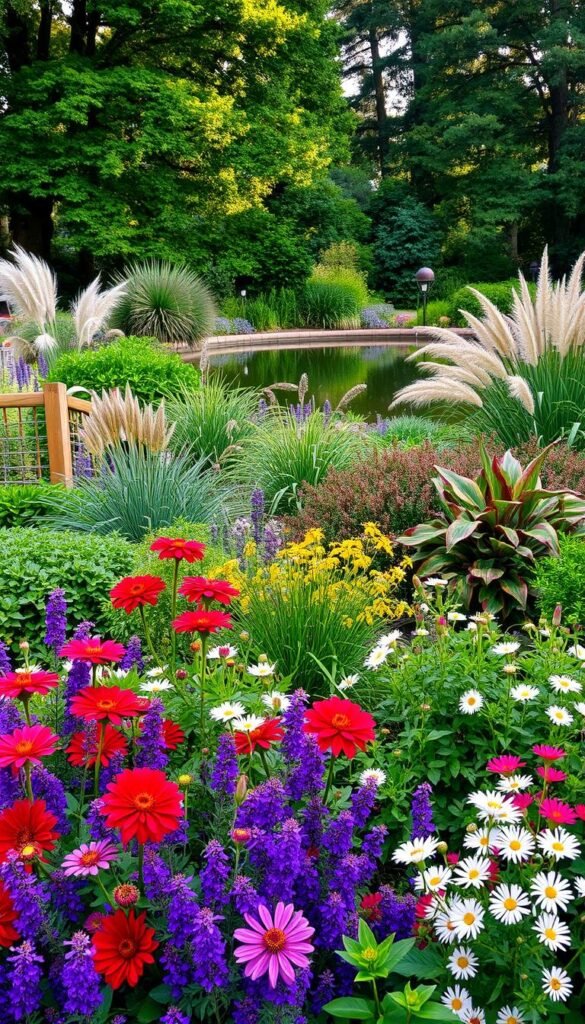
The secret to a captivating outdoor space lies in how you orchestrate color and form. Start by choosing two to three complementary hues—this restraint creates harmony while letting individual plants shine. Landscape designer Butter advises:
“Limit material variations in compact areas. A simplified palette feels cohesive, letting textures and shapes become the stars.”
Layered Beauty Through Strategic Pairings
Cool-toned shrubs like bluebeard or lavender make spaces feel larger when placed at the far end of beds. Pair them with warm orange daylilies up front for depth. Follow this formula:
| Layer | Plant Type | Examples |
|---|---|---|
| Back | Tall shrubs | Hydrangea, smoke bush |
| Middle | Perennials | Coneflowers, salvia |
| Front | Annuals | Marigolds, coleus |
Foliage texture keeps interest year-round. Combine spiky yucca leaves with soft lamb’s ear. For flower garden design principles that balance structure and spontaneity, focus on plants offering multiple seasons of appeal:
- Redtwig dogwood (winter stems)
- Sedum ‘Autumn Joy’ (fall blooms)
- Coral bells (evergreen leaves)
Create focal points with bold elements—a cluster of red Japanese maples or sculptural agave. Surround them with neutral greens to prevent visual chaos. Remember: your eyes need resting spots between bursts of color.
Lighting and Ambience for Evening Garden Magic
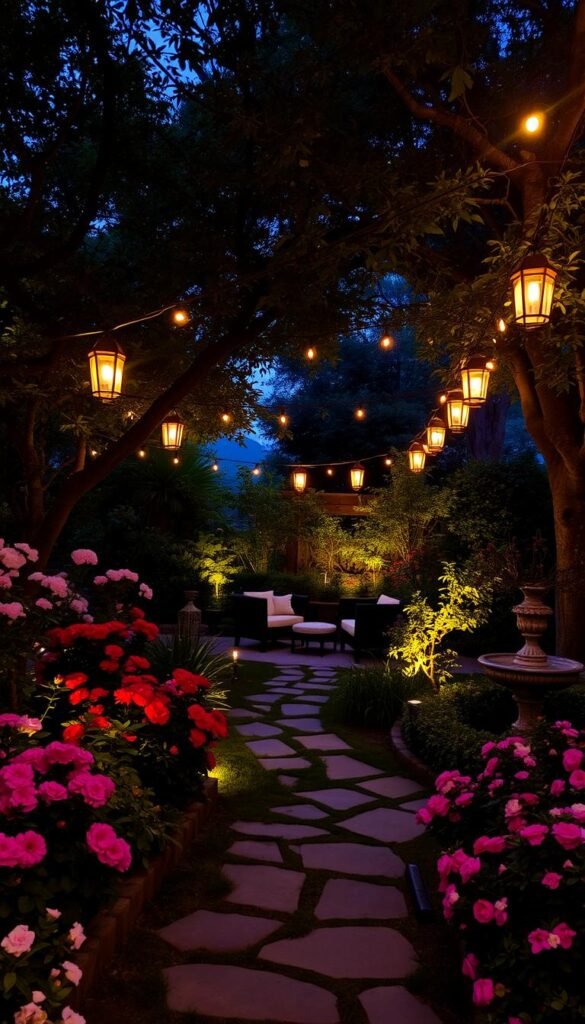
Transform your outdoor area into a twilight oasis where fireflies compete with carefully placed illumination. The right lighting extends your enjoyment long after sunset while adding depth to your favorite features. It’s about balancing artistry with practicality—creating mood without blinding neighbors.
Ambient Lighting Ideas to Highlight Focal Points
Uplight mature trees to cast dramatic shadows on fences. Wrap string lights around pergola beams for a starry canopy effect. Landscape lighting pro James Trevino advises:
“Layer three light types—task, accent, ambient. Moonlight-style path markers paired with spotlit sculptures create intrigue.”
Solar-powered lanterns lining walkways charge by day and glow softly at night. For modern flair, try recessed LED strips under bench seats. They outline seating areas while keeping the focus on your space’s natural beauty.
Practical Tips for Safety and Style
Use warm-toned bulbs (2700K-3000K) to avoid harsh glare. Motion-activated spots deter critters near compost bins. For steps, install low-voltage riser lights every 12 inches—they prevent stumbles without overpowering the scene.
Choose weatherproof fixtures rated for outdoor use. Clean lenses seasonally to maintain brightness. Smart timers or dusk-to-dawn sensors automate your setup, saving energy while ensuring consistency. Your evenings just got cozier—and safer.
Genius Garden Storage and Utility Space Ideas
Ever find yourself tripping over tools while searching for your favorite trowel? Clever storage turns chaotic corners into functional zones that work as hard as you do. Let’s explore ways to hide essentials without sacrificing style.
Smart Storage Solutions for Tools and Utilities
Multi-use furniture saves space and keeps items accessible. A bench with lift-up seats stores gloves and shears, while vertical sheds use wall space efficiently. Landscape pro Lila Moreno suggests: “Paint storage boxes to match your fence color—they’ll blend seamlessly into your garden’s look.”
Repurpose everyday items creatively. Hang old gutters as shallow shelving for seed packets. Use a pegboard with hooks to organize hand tools within reach. For bulky items like hoses, try rolling carts that tuck under decks or benches.
Keep pathways clear with recessed compartments. Bury waterproof bins near planting beds for quick access to stakes and ties. Your space stays tidy, and you’ll spend less time hunting supplies—more time enjoying your green oasis.

